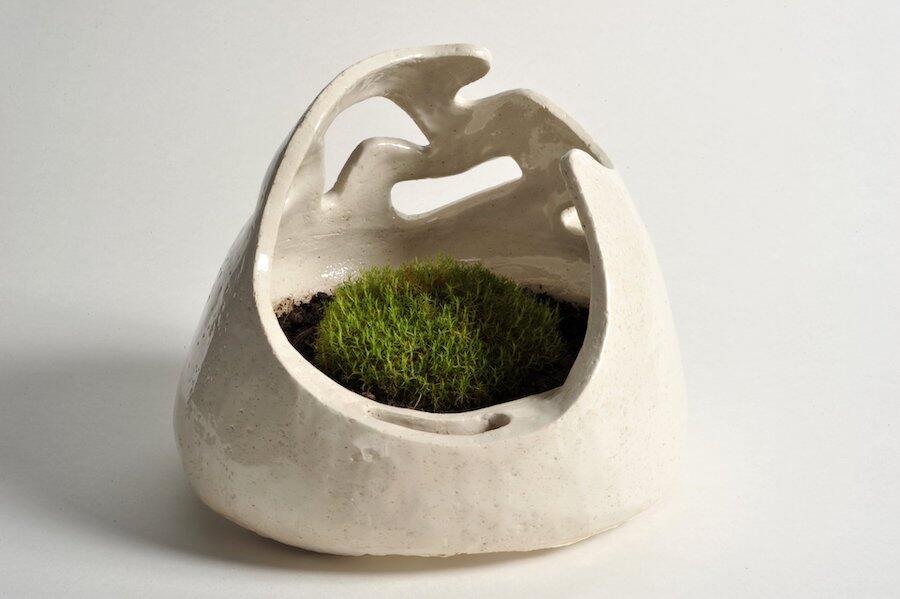The 35th Ljubljana Biennale Restores Faith in ‘Research Art’
This year’s edition focuses on historical relations of resistance and liberation which survive beyond the archive
This year’s edition focuses on historical relations of resistance and liberation which survive beyond the archive

On an abandoned construction site in Ljubljana, Slovenia, Japanese Knotweed thrives between the rubble. This swift-growing plant is notorious as one of the world's most invasive species, but in the hands of the eco-social Krater Collective, which occupies the site, it is transformed into the group’s own brand of Notweed Paper, whose punning name is an invitation to think differently about this supposedly unwanted plant. The collective, who are among the local practitioners invited to participate in the 35th edition of the Ljubljana Biennale of Graphic Arts, operating under the title ‘From the Void Came the Gifts of the Cosmos’, ask audiences to rethink their definitions of native and non-native, challenging common assumptions around natural belonging.

The project is emblematic of the themes that animate this year’s biennale: transnational exchanges, the reframing of social systems and ecosystems through transformative practices and future-oriented propositions of solidarity. It is in keeping too with the history of the biennale. Founded in 1955 in what was then communist Yugoslavia, its focus has always been on exchange, not exchange value, favouring works (often on paper) that could be reproduced and distributed, rather than the artificial scarcity of the original.

Under the direction of Ghanaian artist Ibrahim Mahama, along with a curatorial team of Exit Frame Collective, Alicia Knock, Selom Koffi Kudjie, Inga Lāce, Beya Othmani and Patrick Nii Okanta Ankrah, this year’s exhibition sets out to trace historical and contemporary transnational relations of resistance and liberation in post-colonial and post-imperial states. On the walls of Cukrana, an old sugar factory turned contemporary art space, this act of tracing takes shape in the many research-based works on view. These include Jihan El-Tahri’s captivating Threading of Solidarity (2023), which maps an associative web of affinities between political movements and resistance leaders, originating from a single photograph taken at the first Non-Aligned Movement summit in Belgrade in 1961.
Similarly concerned with mapping, Ilona Németh’s video installation Eastern Sugar Archive, from 2017 (2023), tackles the complexities of the global sugar industry by exploring the gallery building’s history. Convoluted research-driven projects have come to typify biennales in recent years, sometimes to the point of saturation. In Ljubljana, however, they make sense, entering into dialogue with the history of the festival and its setting.

Historically, the biennale was an important meeting point for artists from the East, West and South. Politics was always on the table, and art a catalyst for dialogue and conversation. In many ways, the atmosphere of open exchange that many contemporary exhibitions strive to foster seems to naturally thrive in Ljubljana. This year’s edition taps right into that fertile ground. At the MGLC, Ljubljana’s International Centre of Graphic Arts, one section pays homage to printmakers who have graced past editions of the biennale with beautiful etchings by Assadour Bezdikian, Silvi Liiva, Marje Üksine and Lalitha Lajmi, alongside silkscreen and linocut prints, mostly from the 1970s and 1980s. From Iraq, Estonia, India, Egypt and further afield, these works celebrate distribution, outreach and communication; the reproducibility of the medium is the message.

Other notable works include a mesmerizing woodcut of an agricultural landscape from Soghra Khurasani’s 2022 series ‘Shadows under my sky’, and Jaanus Samma’s Wedding Rug (2023), which employs traditional Estonian weaving techniques and infuses them with queer symbolism. Sprawling across almost all exhibition spaces are the moss gardens of Beti Frim and Ines Sekač, the exhibition's youngest contributors, who are still enrolled at the Academy of Fine Arts and Design at the University of Ljubljana. From the Moss-centric Era (2023) presents an array of ceramic moss containers, each harbouring a QR-code-triggered augmented reality layer, in which otherworldly creatures hover above miniature gardens, sharing tales both from and about the moss.

Back in Cukrana, One Man Does Not Rule a Nation (2023), a collaborative research project by Max Cegielski and Janek Simon, centres around a monument dedicated to Kwame Nkrumah, the first president of post-independence Ghana. This monument, designed by Polish sculptor Alina Ślesińska and unveiled in Winneba, Ghana in 1965, was dismantled the following year during a CIA-endorsed coup to remove anti-imperialist Nkrumah from office. The installation comprises a comprehensive amalgamation of archival materials, newly conducted interviews with eyewitnesses, and a model of the monument itself. This interdisciplinary research sketches many interwoven points of correlations between the Eastern European and West African trajectories. The artists’ aim was not only to draw attention to this story but also to expose how it continues to influence the present. One Man Does Not Rule a Nation is a compelling instance of an investigative endeavour that finds space for its fullest expression within the flexible contours of the contemporary art sphere.

This approach is, of course, not new. The methods and aesthetics presented in the biennale will surprise but a few. However, the specific historical and geopolitical contexts of the Ljubljana Biennale and the bonds of affinity and exchange established by the curators and artists make this a most aligned and meaningful exhibition. Indeed, the void in the biennale’s title – ‘From the Void Came the Gifts of the Cosmos’ – is not a lack of something but rather a space-making strategy. It is a curatorial framework that truly provides room for the works and allows the relationships growing around them to emerge; a space where the past is the base for a meeting in the present.
The 35th edition of the Ljubljana Biennale of Graphic Arts is on view until 14 January 2024.
Main image: Ilona Németh, Eastern Sugar, 2017–18. Courtesy: the artist; photograph: Olja Triaška Stefanović






















